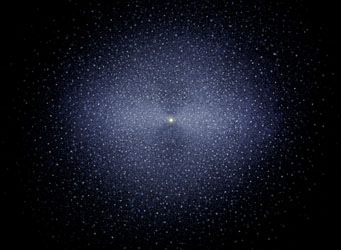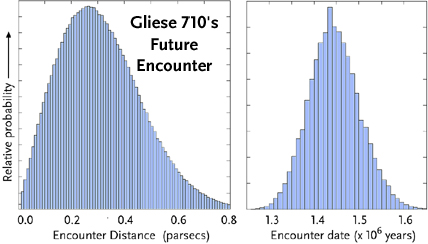Purveyors of doom often look to the heavens for their protagonists. During the 1980s, we were briefly captivated by Nemesis, a supposed companion of the Sun that triggered a death-dealing rain of comets every 26 million years. During the 1990s we endured wild speculations about Nibiru, which managed somehow not to destroy Earth in 2003.
Now there's a new threat — but unlike Nemesis and Nibiru, this one's real. It's called Gliese 710 (pronounced GLEE-zuh), an obscure, 10th-magnitude orange dwarf star situated about 63 light-years away in the constellation Serpens. Astronomers first took note of this modest star about a decade ago, when Joan García-Sánchez (Jet Propulsion Laboratory) and others found, based on positional observations from the Hipparcos satellite, that in roughly 1½ million years Gliese 710 should pass about 1.3 light-years from the Sun.

The Oort Cloud, which envelops our solar system with perhaps trillions of icy objects, extends to perhaps 5 trillion miles (50,000 astronomical units) from the Sun.
Don Davis
That's not close enough for the gravitational pull of a 0.6-solar-mass star to unhinge the planets from their current orbits. But it would stir up some trouble in the Oort Cloud, the storehouse of perhaps a trillion comets that theoretically extends to the limit of the Sun's gravitational grip. García-Sánchez and her team estimated that 2.4 million Oort Cloud denizens might be perturbed into Earth-crossing orbits over a couple million years, increasing the risk of our planet being hit by a long-period comet by only 10%. No big whoop.
But a revised Hipparcos catalog of stars' distances and motions came out in 2007, and a fresh analysis of that and other datasets by Vadim V. Bobylev (Pulkovo Astronomical Observatory) shows that Gliese 710 is a little more problematic than first thought.
After running a million computer simulations that factored in various observational errors, Bobylev confirms that the star has an 86% chance of passing through the Oort Cloud's outer limit, assumed to be 1.6 light-years from the Sun. Moreover, the simulations yield a 1-in-10,000 chance of skirting within 0.02 light-year, or about 1,000 astronomical units. A star passing by only 50 times farther out than Pluto would wreak havoc within the Oort Cloud, sending a long-lasting pulse of comets throughout the planetary system.
Yet all the comets stashed in the Kuiper Belt, and the planets themselves, would not likely be affected, since the Sun's gravitational force on a typical comet in the belt would still be thousands of times stronger than the tug from the passing star.
"The way to think about what is happening," notes dynamicists Hal Levison (Southwest Research Institute), "is to realize that the star gets closer to the sun than to the vast majority of comets. So the Sun's velocity is changed while the Oort cloud in not. The Sun heads off in a new direction while to Oort cloud keeps going in the original one."

These plots show the likely distance and timing of a future encounter with the dwarf star Gliese 710. A parsec is 3.26 light-years.
Vadim Bobylev
Could such a close encounter really happen? It probably already has. Dynamicists point to the fact that the Kuiper Belt appears to end abruptly at a distance of about 60 a.u. Then there's the strange 12,000-year orbit of 90377 Sedna, whose solar distance ranges between 76 and 976 a.u. No mere planetary encounter could have flung Sedna out that far; the only plausible explanation is the gravitational yank from a close-passing star long ago.
On the plus side, Bobylev's analysis of 35,000 stars within 100 light-years of the Sun didn't turn up any new interlopers of consequence within the past or forthcoming 2 million years. He's added nine new stars to the list of past or future encounters of 6½ light-years or less, none of which come nearly as close as Gliese 710. Some 27 and 28 million years from now, respectively, the stars Proxima and Alpha Centauri sail past our solar system but come no closer than 3 light-years.
 12
12
Comments
Andrew Bennett
March 17, 2010 at 11:27 am
Surely Sedna's period is 4 million DAYS - about 12,000 years. But interesting stuff...
You must be logged in to post a comment.
Justin
March 18, 2010 at 7:53 am
I would not be astonished if Gliese 710 has its own fleet of comets. Considering the relative velocity of GLeise 710 to the solar system, this could produce some spectacular collisions.
You must be logged in to post a comment.
Alan MacRobert
March 19, 2010 at 7:54 am
> if Gliese 710 has its own fleet of comets....
Their high velocity with respect to the Sun would mean the Sun would have very little "focusing effect" drawing them inward, very unlike the Oort cloud comets. So, relatively few of the passing comets would make it into the unner solar system. This is the same reason why there has never yet been an interstellar comet observed, though lots of stars should have shed them.
Alan MacRobert
You must be logged in to post a comment.
Kelly Beatty
March 19, 2010 at 8:26 am
Thanks, Andrew. Sedna's orbit is now correct — and I've added some comments by outer-solar-system expert Hal Levison.
You must be logged in to post a comment.
Michael C. Emmert
March 19, 2010 at 9:03 pm
It's just a lot smaller than Raup, Sepkoski, Muller, ALVAREZ, et. al thought it would be. Trust me. I've put this on GravitySimulator.
Look at all those inclined orbits in the Kuiper belt. It's been disturbed by some object. That object has shaken loose comets from the closer, denser Kuiper belt, rather than the Oort cloud. Richard Muller found evidence by dating lunar spherules (like vacuum tectites) and found it had gotten loose about 500 million years ago. That's why some Gliese 710 - like object didn't sweep it away. It almost did.
Well, this post is too short. I predict the object will be found by WISE and will be between 5 and 25 Jupiter masses.
You must be logged in to post a comment.
Dave
March 20, 2010 at 5:47 am
How can something that is not there be disturbed? The Oort cloud doesn't exist. When you invent a solution to answer a vexatious question and it becomes holy writ then any other hypothesis based upon that acceptance serves to occlude investigation into the original problem. The Oort cloud is poor science.
You must be logged in to post a comment.
Kevin Heider
March 21, 2010 at 4:33 am
Proxima and Alpha Centauri make their closest approaches in about 27 and 28 THOUSAND years.
You must be logged in to post a comment.
Ali
March 23, 2010 at 3:58 am
what is orange dwarf star? Something between red dwarf and brown dwarf?
You must be logged in to post a comment.
Kevin Heider
March 26, 2010 at 4:07 am
An "orange dwarf" (K class) star is between a sun-like (G-class dwarf) and a red dwarf (M class). Largest to smallest is: "Oh, Be A Fine Girl, Kiss Me".
You must be logged in to post a comment.
Rod
March 27, 2010 at 10:38 am
There is plenty of faith in the Oort Cloud model in astronomy. It appears to explain long period comets entering the ecliptic from different directions but to date, it has never been observed or its mass measured like we can for binary star orbits. The origin of the Oort Cloud is model dependent concerning assumptions about initial conditions in the ecliptic some 4.56 billion years ago. Folks need to be careful when reading reports like we see posted here.
You must be logged in to post a comment.
Torbjörn Larsson, OM
March 28, 2010 at 8:01 am
On the up side, life will continue in any case. Or at least if Abramov and Mojzsis models of microbial habitability in Hadean LHB predict the correct outcome: "there is no plausible situation
in which the habitable zone was fully sterilized on Earth" since cells multiply and migrate faster than sterilizing impacts can keep up.
@ Dave: If you disregard science use of theory, prediction and testing, you will retreat into cryptoinductivism of pure observation. That is not viable.
Luckily inductivism itself tells us it doesn't work: induction on the unquantifiable uncertainty of induction leaves us with unquantifiable uncertainty. At the same time testing passes an analogous meta test: testing testing tells us that the prediction of quantifiable uncertainty gives a quantifiable uncertainty which passes "beyond reasonable doubt". (You can use a binomial go/no go test. Roughly 5 years of current science output will suffice for such a test at 3 sigma under mild assumptions on the amount of testing.) Theory rocks!
As for the Oort cloud model, I believe it passes more tests than just predicting observed comets, such as predicting where the remaining protoplanetary disk material goes. It would be really hard to come up with competing models that does better on those observations. Anywho, Kepler is predicted to be able to observe Oort clouds, so perhaps in 3 years we will test conclusively.
You must be logged in to post a comment.
Tony Flanders
March 28, 2010 at 2:55 pm
"Cryptoinductivism of pure observation" is a mighty cryptic phrase; there has to be some way to say this in plain English. But of course I agree with the basic statemwent. There's precious little doubt about the existence of the Oort Cloud. It's a delicious example, like neutrinos, of an extremely solid scientific prediction made long before there was any hope of direct verification. - Tony Flanders, Associate Editor, S&T.
You must be logged in to post a comment.
You must be logged in to post a comment.